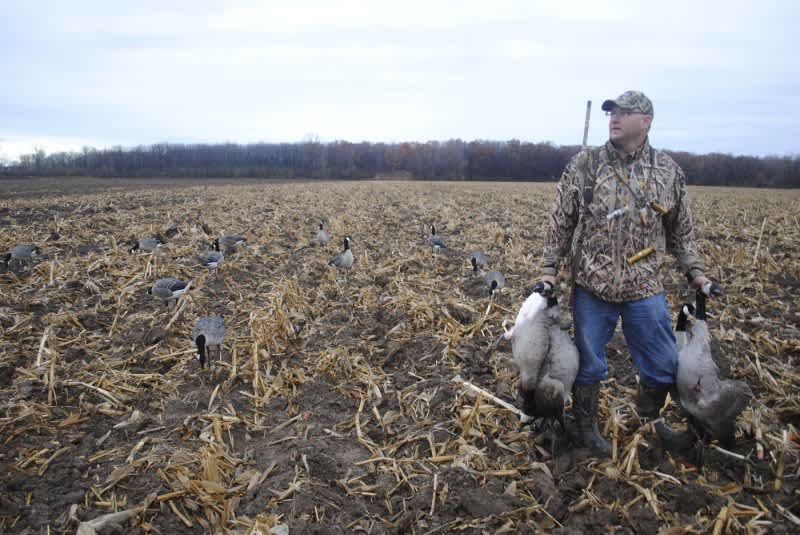Hunting Michigan Late Regular Season Geese
Bob Gwizdz 12.18.15

Joe Robison had been scouting a cut corn field for a while, watching hundreds of geese pour into it in late morning. We made a plan to be there before dawn on Friday.
On Thursday, the farmer chisel-plowed the field. It didn’t change our plan; it just made everything a little bit tougher.
“It’s harder to than heck to hide in a chisel plowed field,” Robison said. “These geese are going to be here. But we’re not going to be able to drive everything out there to set up.”
To top things off, it was raining. It wasn’t coming down hard, but it meant we were going to have to slog five or six dozen full-bodied decoys and a couple of ground blinds across several hundred yards of mud—the kind of clay mud that builds up on your boots so you’re trudging in ’70s-style platform shoes—to get to where we needed to be.
We managed. It was hard work, but we got the gear out, put together the blinds, and set the decoys. Then it really started raining.
So five of us hunkered in the open-topped blinds, heads down, letting the rain pelt our parkas until it subsided. Not too long after daylight, the geese started flying.
A flight of seven Canada geese came our way, then seemed to change their mind, veering off as they approached our set.
“Better take them,” Robison said. We stood and fired; four birds hit the dirt.
We scrambled out to pick them up but before we were even close to getting back, another small flight was headed our way. Ever try to run through the mud wearing foul-weather gear and 20-pound boots?
But we made it and the birds, about a dozen, didn’t seem to notice us. We were set up perfectly and the geese barreled in right toward the middle of our spread. The two blinds we had set up (Zink Avian-X A-Frames, camouflaged with tall grass) didn’t seem to bother them a bit.
“Remember, we can only shoot six,” Robison said. “Take ‘em.”

I stood up, chose a bird, dispatched a load of three-inch BBs toward it and watched it crumple.
I don’t know which member of the group had it together to shoot a second bird, but six geese hit the ground. Our morning was over after about 10 minutes of shooting.
The daily limit of two per hunter—you can generally take a five apiece during the early September and late winter goose seasons—is something the feds have come up with to protect the migrant Canadas. In the early and late seasons, the geese are virtually all resident giant Canadas. Except in the Upper Peninsula and the managed goose hunting units in the Saginaw Bay Area (Saginaw and Huron-Tuscola GMUs), where the limit of five per day only applies for the first 10 days of the season, there’s not much worry about killing the visitors from Canada.
But during the regular waterfowl season, the smaller interior geese are sprinkled in with them.
That’s what makes the goose hunting regulations so complex.
But that might be coming to an end.
The US Fish and Wildlife Service is making some changes in the overall framework, which could mean more goose hunting opportunities and a higher daily bag limit during the regular season for Michigan goose hunters.
The Department of Natural Resources (DNR) is looking at proposing a somewhat different set of regulations for next year. In short, the “early” goose season could be elongated to the entire month of September in most of the state.
The Upper Peninsula could have a bag limit of five through September 15, as could the managed goose hunting units around Saginaw Bay (though the DNR will revisit whether those GMUs are necessary any more).

In addition, the daily bag during the regular goose season would be raised to three. That means our hunt, that morning, would have lasted a couple of more minutes as the geese really started flying. They were trying to get in there while we were picking up dekes.
Robison, a hard-core waterfowl hunter and the DNR’s liaison with the state’s Citizens Waterfowl Advisory Committee (CWAC) thinks the changes may be good for Michigan goose hunters.
“I’ve been hearing from a lot of goose hunters who would rather have a three-goose limit,” Robison said. “We’ve always had the option to go to a three-bird bag, but we’ve chosen to have a two-bird bag so we could have more days. Now it looks like we can do that and still keep 107 days.”
The trade off, for the changes, would be the late-season bag limit would be reduced from five to three. Robison said he thinks that’s fair trade.
“We’ll lose out on five in the late season,” he said, “but more guys are goose hunting in October, November and December than there are in January and February.
“Nothing’s final,” Robison said. “We meet with the CWAC in January. But a big change is we’ve always had to set our final regulations in August. This year everything should be set ahead of time. If it works out, the Natural Resources Commission will be able to vote on it in March. We’ve always heard from a lot of hunters that they hated waiting until August to find out when the season was because they said they couldn’t put in for their vacations in advance.
“It could be a huge change from the past regulation process.”
I’ll go for that. Giving up a couple of weeks of five-bird bags during the worst of winter in exchange for more days of three-bird bags during the peak of season sounds like a good deal to me.
For more information on Michigan hunting go to michigan.org. Click here to purchase a Michigan hunting license online.
This article was produced in partnership with Pure Michigan.

